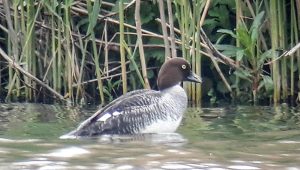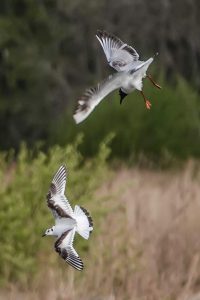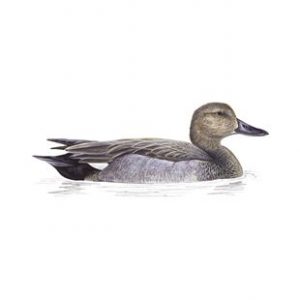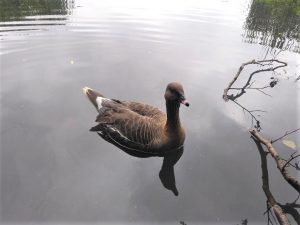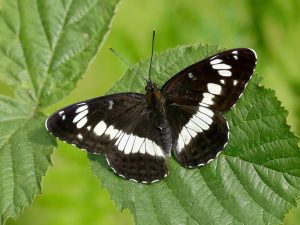William Legge writes:
To say that this period’s weather was mixed is probably an understatement. Following an unseasonably cold, but sunny April and a cold wet and windy May, hints of summer finally broke through in early-June. Still, truly fine days were generally at a premium and when they came the mercury sizzled! Birding-wise it was a busy few months with spring migration delivering both the expected and the unexpected and a breeding season that is turning out to be the best this century.
April-May
Despite the colder conditions, spring migrants arrived largely on schedule, with the first House Martin logged on April 1st, Willow Warbler on 3rd, Whitethroat on 5th, two Reed Warblers on 14th, Sedge Warbler on 21st, three Swifts on 25th and three Garden Warblers on 26th. Willow Warblers, purely a passage migrant at Fleet Pond these days, put in a particularly good showing with a peak of nine present on April 13th. There were plenty of late winter migrants encountered too with an influx of Brambling between April 6th-21st, peaking at 15 on 14th, along with small numbers of Lesser Redpoll until April 14th, Siskin until 19th and the last Redwing on 15th.
Scarcer migrants included a 2nd calendar year (CY) male Marsh Harrier flying low over the Pond early on April 11th; the reserve’s third recorded bird of the species over the last 12-months after a barren decade. A female Redstart was sighted working its way through the woodland on the east side of the Reserve on April 14th.
A Dark-bellied Brent Goose seen from the Lions’ View platform was an excellent find early on April 16th, representing the site’s first record since October 2005. It is suspected of being the individual that resided at nearby Tice’s Meadow for much of this spring.
A Great White Egret dropped into the Reserve at midday on April 28th during heavy rain, and remained hunkered down in the heronry through to the end of the day. A vocal and mobile Ring-necked Parakeet was seen in trees adjoining the station car park for an hour on April 30th.
Migrant wildfowl included the discovery of a female (2nd CY) Common Goldeneye (pictured above) associating with Tufted Ducks on May 14th, representing the first May record for Fleet Pond and the first Goldeneye at the Reserve since 2014. More expected were sightings of Hobby from April 30th onwards, Cuckoo from May 2nd and single Peregrines on April 21st and May 4th, respectively. Flyover migrants included seven Yellow Wagtails over the north on April 28th and two Ravens heading southeast on May 12th.
In contrast to Spring 2020, migrant waders disappointed with the only notables being Common Sandpipers on April 13th and May 7th; a flyover Oystercatcher on May 13th and good numbers of Common Snipe into the third week of April including 16 on 13th.
Migrant terns were also lighter than usual. The first Common Tern was logged on April 16th, with two regularly seen from April 19th into mid-May and a high count of four on May 8th. The only other tern species noted was an Arctic Tern on May 4th. On the other hand, gulls didn’t disappoint with the spring build-up of Black-headed Gulls peaking on April 19th when 1,200 roosted, comprising a mixture of migrants and the Reserve’s returning breeders. Mediterranean Gulls again flirted with the Black-headed Gull colony with a minimum of 13 individuals logged between April 1st and May 15th. There were peaks of four on April 16th and 19th, including a pair which remained in residence to April 30th. Scarcer gulls included a brief adult Kittiwake on April 5th, two Common Gulls on April 19th and a single on May 8th. Single Little Gulls (pictured below) were sighted on April 24th (adult), 28th (2nd CY), May 3rd (adult) and another 2nd CY between May 4th-15th which subsequently relocated to nearby Tice’s Meadow.
June and the Breeding Season
The biggest gull surprise was the persistent presence of several Herring Gulls (illustrated below) well into the spring.
By mid-May a pair settled down to nest on Cormorant Island, hatching a single chick which was first seen on June 16th and was swimming by July 7th. While Herring Gull is a regular sight at Fleet Pond in winter and a regular flyover migrant throughout the year, this pair represents the first ever record of Herring Gull breeding at Fleet Pond. With a Hampshire breeding population of around 200 pairs, almost all centered around Southampton and the adjoining coastal area, inland breeding remains rare within the county.
Two hundred pairs of Black-headed Gull raised an estimated 100 young this year, well down on recent summers with the lack of success put down to the stormy weather experienced in mid-to-late May.
Gulls aside, it was an amazing year for breeding wildfowl and a few other species as well. Not only were there record numbers of ducks breeding, but the survival rate of the young seemed to be higher than it has been in decades. What’s the secret ingredient this year? Well, it appears Fleet Pond’s better water quality, increased aquatic invertebrate and plant populations, particularly the growth of horned pondweed, provide some answers, in part due to last year’s fish die off. The numbers tell the story with 21 broods of Mallard (30+ young raised), 12 broods of Tufted Duck (30+ young raised), seven broods of Gadwall (illustrated below) (22+ young raised), and one brood of Pochard (four young raised).
In addition, it is believed that two pairs of Shoveler attempted to breed but were unsuccessful. The re-establishment of Pochard as a breeding species is particularly pleasing after an absence of 26 years and the stunning success of Gadwall is notable. One pair of Mute Swan are raising five cygnets (down from seven) while there were at least eight broods of Canada Geese (15+ young raised) and two pairs of Greylag Geese, the latter producing seven young, none of which survived. Coot also had a strong breeding season with 13 broods from ten pairs, with the Pond’s conditions attracting an influx of others. A count of 80 in mid-July is the highest Coot count at the Reserve in over 40+ years! At least one pair of Water Rail were successful. Passerine breeding included a pair of Cetti’s Warblers adjoining Hemelite Bay, and Reserve territory counts of 30 Reed Warbler, 23 Blackcap, ten Chiffchaff, seven Reed Bunting, five Whitethroat, three Garden Warbler, two Sedge Warbler and one Firecrest (Brookly Wood).
June on-breeding scarcities were few, but a Pink-footed Goose (pictured above) which arrived with a flock of Greylag Geese on June 16 certainly caused heads to turn. Remaining in residence until at least July 15, it undertook its annual moult with other geese at the pond, a time when geese are unable to fly for a few weeks. Pink-footed Goose is a winter visitor to northern Britain and East Anglia, and this individual should have been in Iceland or Greenland right now but for some reason, perhaps health or as a lost and inexperienced young bird, it decided to remain in the UK. Whilst it could conceivably be an escapee, the former explanation is believed to be more likely. Otherwise, June pickings included a flock of four Ravens over west on June 12th and an adult Little Grebe on the Little Pond on June 28th.
Switching to invertebrates, there were some notable butterflies encountered at the Reserve with a White Admiral (Gelvert Stream) (pictured below) and the Wood Lane Heath attracting at least nine Silver-studded Blue, Essex Skipper and several Large Skipper.
It was a packed three months and now with the autumn migration underway, anticipation is high. Good Birding!
Contributing Observers: Evelyn Auld, David Buckler, Ed Butler, John Clark, D Cox, K P Duncan, N Hayward, J Kennett, S Mansfield, S Miles, J Mist, P Rowse and Graham Stephenson.
Picture credits: Little Gulls, Common Goldeneye—Ed Butler; Pink-footed Goose—Graham Stephenson; Bird illustrations—RSPB www.rspb.org.uk/birds-and-wildlife/wildlife-guides/bird-a-z/
White Admiral butterfly—Iain Leach White Admiral (butterfly-conservation.org)
Ed’s note: William refers to Tice’s Meadow Reserve a couple of times in his report. If you want to know more about this site visit their website: Tice’s Meadow (ticesmeadow.org)

